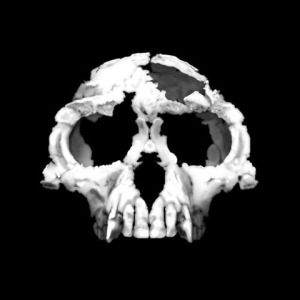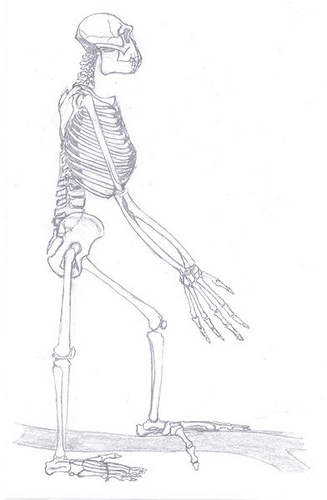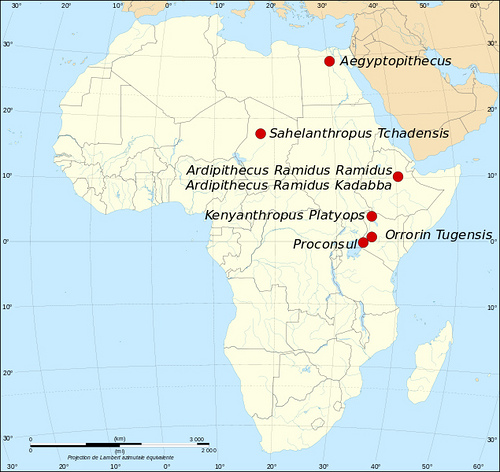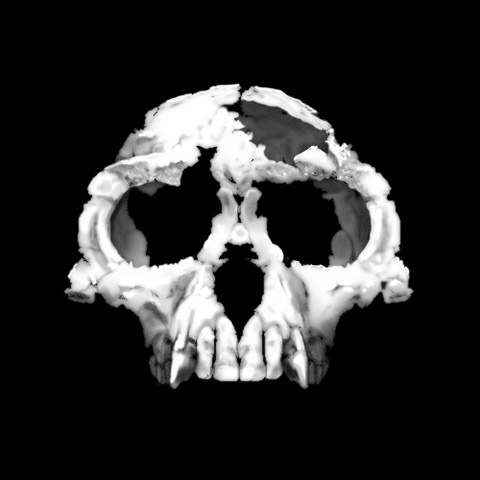
A new study, published in the Proceedings of the National Academy of Sciences (PNAS), may strengthen the argument for an evolutionary link between Ardipithecus ramidus (nicknamed ‘Ardi’ for short), a 4.4 million-year-old hominoid species that featured a brain about the size of a chimpanzee but locomotor behavior that may have included both walking upright on the ground and a life in the trees, and humans. A hominoid is a type of animal belonging to the superfamily Hominoidea, consisting of both apes and humans.
Ardipithecus ramidus, now long extinct, is the biological species name given to fossils first discovered in 1992 by a research team led by Tim White. Exploring the Afar Depression in the Middle Awash river valley of Ethiopia, they found seventeen fragments including skull, mandible, teeth and arm bones. Later, additional fragments were recovered in 1994. The pelvis remains of Ardi, which were found in a crushed state, were analyzed and interpreted to be shorter and broader than an ape’s — more like that of a human or Australopithecus, indicating that she was bipedal, able to walk upright. White and colleagues initially classified it as belonging to Australopithecus, a more human-like genus thought to be ancestral to humans, but later renamed the fossil finds under a new genus, Ardipithecus. Then, between 1999 and 2003, another team led by Sileshi Semaw discovered fossils of nine A. ramidus individuals at As Duma in the Gona Western Margin of Ethiopia’s Afar Region. These fossils were dated to between 4.35 and 4.45 million years old. Questions surrounding how this species is related to human ancestors have been long debated, with many scholars suggesting it represents evidence of homoplasy, or independent evolution of similar features in species of different lineages. In the case of Ardi, the homoplasy adherents have pointed out that certain aspects of the foot and pelvis which are strongly indicative of arboreal locomotion (life in the trees, like other primates), suggest that this species may instead “exemplify parallel evolution of human-like traits among apes around the time of the chimpanzee-human split”.*
__________________________________________________________________________________________
Ardipithecus ramidus („Ardi“), complete skeleton. Own drawn remake of p.36, “Science” of 2nd October 2009. Tobias Fluegel, Wikimedia Commons
_________________________________________________________________________________________
A map with the fossil sites of the earliest hominids and hominoids, from 35.8 M BP until 3.3 M BP.
_________________________________________________________________________________________
Now, an international team of scientists, including study authors William H. Kimbel of Arizona State University and Tim D. White of the University of California, Berkely, report that key morphological aspects of the base of the Ardi skull (the basicranium) indicates affinities to that of the Australopithecines and early Homo, supporting the hypothesis that Ardi had a closer relationship to humans than the homoplasy supporters suggest. Report the study authors:
“Our investigation of the basicranium shows that Ar. ramidus shares with Australopithecus and Homo a relatively short, broad central cranial base and related modifications of the tympanic, petrous, and basioccipital elements. These similarities support the proposed relationship of Ar. ramidus to Australopithecus + Homo. Reorganization of the central basicranium is among the earliest morphological attributes of this group.”*
The researchers came to this conclusion after analyzing the length and breadth of the external cranial base of the skull, including the temporal bone , of the best-preserved basicranial specimen of Ardi and similar samples from Australopithecines, chimpanzees, bonobos, and modern humans.
_________________________________________________________________________________________
Ardipithecus cranium image. Michael Keesey, Wikimedia Commons
_________________________________________________________________________________________
Other key researchers and study authors included Gen Suwa of the University of Tokyo, Berhane Asfaw of the Rift Valley Research Service, Addis Ababa, Ethiopia, and Yoel Rak of Tel Aviv University and Arizona State University.
________________________
*Article #13-22639: “Ardipithecus ramidus and the evolution of the human cranial base,” by William H. Kimbel et al., Proceedings of the National Academy of Sciences
________________________________________________________________________________________________________________________
Read about the most fascinating discoveries with a premium subscription to Popular Archaeology Magazine. Find out what Popular Archaeology Magazine is all about. AND MORE:
 On the go? Purchase the mobile version of the current issue of Popular Archaeology Magazine here for only $2.99.
On the go? Purchase the mobile version of the current issue of Popular Archaeology Magazine here for only $2.99.
And, Popular Archaeology’s annual Discovery edition is a selection of the best stories published in Popular Archaeology Magazine in past issues, with an emphasis on some of the most significant, groundbreaking, or fascinating discoveries in the fields of archaeology and paleoanthropology and related fields. At least some of the articles have been updated or revised specifically for the Discovery edition. We can confidently say that there is no other single issue of an archaeology-related magazine, paper print or online, that contains as much major feature article content as this one. The latest issue, volume 2, has just been released. Go to the Discovery edition page for more information.
Subscription Price: A very affordable $5.75 for those who are not already premium subscribers of Popular Archaeology Magazine (It is FREE for premium subscribers to Popular Archaeology). Premium subscribers should email [email protected] and request the special coupon code. Or, for the e-Book version, it can be purchased for only $3.99 at Amazon.com.








